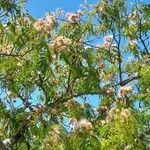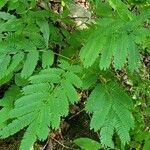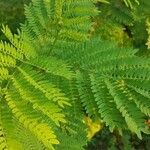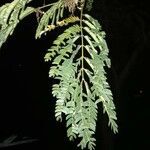A tree which grows up to 12 m tall and spreads to 10 m wide. It loses its leaves during the year. The crown tends to be flat. The bark is dark brown and smooth. The leaves are twice divided. Each primary leaflet has 20-30 pairs of secondary leaflets. These are 1.5 cm long. The leaflets fold together at night. The flowers are in round pink heads. The stamens are long and silky. The fruit are seed pods. They are 15 cm long.
Widely spreading, soft-wooded tree to 10 m; lvs 2–5 dm; pinnae 4–12 pairs, 1–2 dm; lfls 20–30 pairs, oblong, 10–15 mm, mucronate, very inequilateral; fls pink, in long-peduncled heads forming a terminal raceme; cal 2–2.5 mm; cor 5–8 mm; stamens 15 mm; fr 10–15 × 2 cm; 2n=36. Native of tropical Asia, hardy as far n. as s. N.Y., and often escaped from cult. southward. June–Aug.











